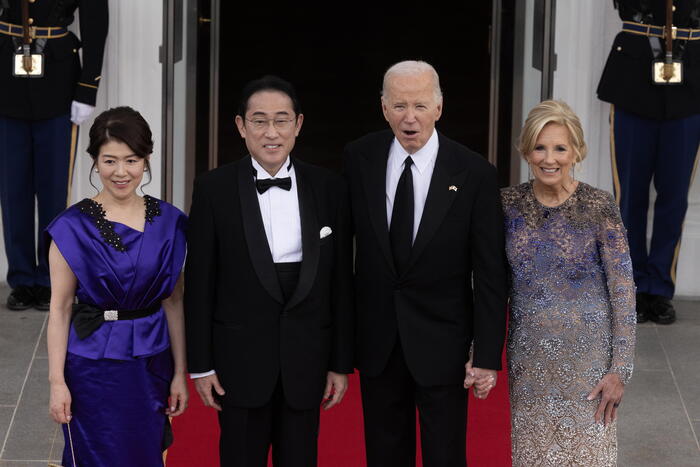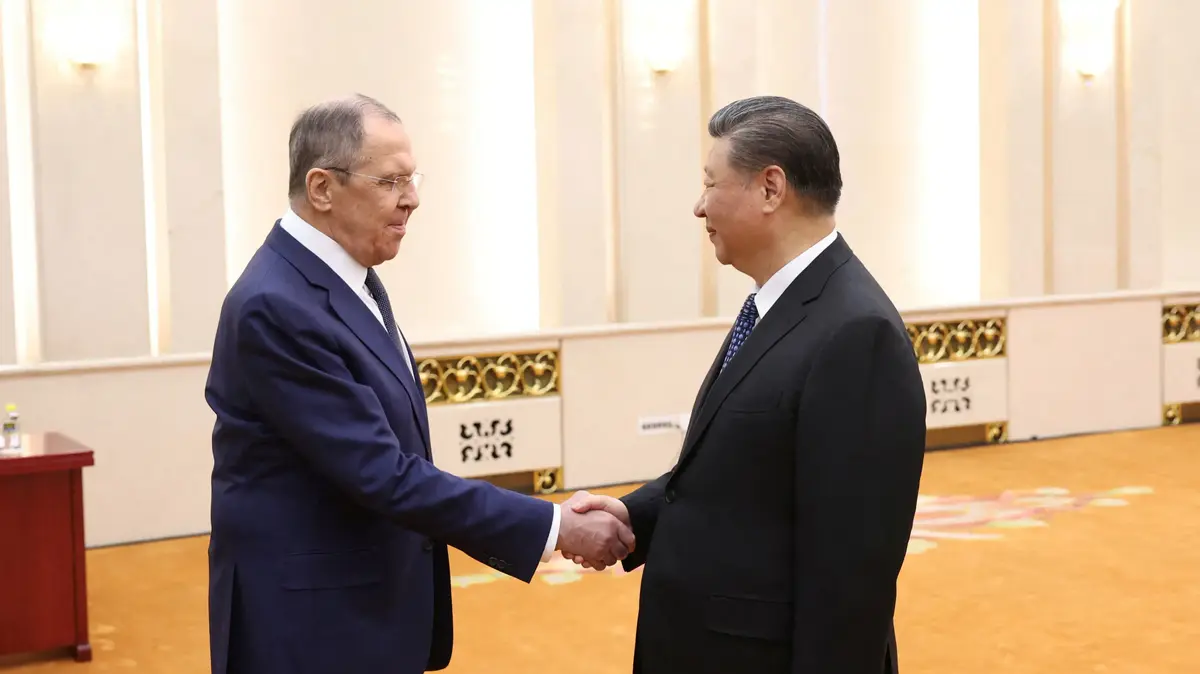China seems to expand its nuclear capacity 0:49
(CNN) -
China is building a second missile silo base in its western deserts, according to a new study, which researchers say points to a possible expansion of its nuclear arsenal and calls into question Beijing's commitment to its strategy. of "minimal deterrence".
Identified through satellite images, the new missile base in China's Xinjiang region may include 110 silos, according to the report released Monday by the Federation of American Scientists (FAS).
China is building an extensive network of missile silos, satellite images appear to show
It is the second field of silos apparently discovered this month by the researchers, adding to the 120 silos that appear to be under construction in the neighboring province of Gansu, according to the James Martin Center for Non-Proliferation Studies.
Together, the two sites signify "the most significant expansion of the Chinese nuclear arsenal of all time," according to the FAS report.
CNN has contacted the Chinese Ministry of Foreign Affairs and Defense Ministry for comment on the latest report.
Earlier, some Chinese media outlets dismissed reports about the missile silo field in Gansu, suggesting it was a wind farm, but the claim has not been confirmed by Beijing.
advertising
This satellite image from Planet Labs shows what researchers say are missile silos under construction in China.
Adam Ni, director of the Canberra-based Center for China Policy, said the discovery of the apparent silo fields is "quite compelling evidence of China's intention to significantly expand its nuclear arsenal, in a faster way than it is. that many analysts have predicted so far. "
For decades, China has operated about 20 silos for its liquid-fueled ICBMs, called DF-5s;
now, it appears to be building 10 more, possibly to house its most recent ICBM, the DF-41, according to the FAS report.
The longest silo construction since the Cold War
"The Chinese missile silo program constitutes the most extensive silo construction since the construction of US and Soviet missile silos during the Cold War," the report says.
"The number of new Chinese silos under construction exceeds the number of silo-based ICBMs operated by Russia, and constitutes more than half the size of the entire US ICBM force."
The seemingly rapid build-up has raised questions about whether China remains committed to keeping its nuclear arsenal at the minimum level necessary to deter an adversary from attacking, a policy Beijing has adopted since it detonated its first atomic bomb in the 1960s.
The "minimal deterrence" stance has historically kept China's nuclear weapons at a comparatively low level.
The Stockholm International Peace Research Institute (SIPRI) estimates that China has about 350 nuclear warheads, a fraction of the 5,550 owned by the United States and 6,255 by Russia.
However, China's number of warheads has increased in recent years, from 145 warheads in 2006, according to the institute.
The Pentagon predicts that China's arsenal will "at least double in size" over the next decade.
A DF-5B ICBM during a parade in Beijing, China, in 2019. (Credit: GREG BAKER / AFP via Getty Images)
"The posture of China's nuclear force has evolved steadily over the past 10 years, with mobile road missile launchers recently being joined by the nuclear-capable H-6N bomber, a new ballistic missile launched from a submarine, and increasing numbers of static silos, giving China an increasingly robust and survivable nuclear triad, "said Drew Thompson, former US Department of Defense official and visiting principal investigator at the School. Professor Lee Kuan Yew from the National University of Singapore.
In a statement provided to CNN, a spokesman for the US State Department described the apparent build-up as "deeply troubling," noting that it raised questions about China's true intent.
"Despite the obfuscation of the PRC, this rapid build-up has become more difficult to conceal and highlights how China is deviating from decades of nuclear strategy based on minimal deterrence," the spokesman said, referring to China for the acronym for its official name, the People's Republic of China.
"These advances show why it is in everyone's interest for nuclear powers to speak directly to each other to reduce nuclear dangers and avoid miscalculations," the spokesman added.
Minimal deterrence
The FAS report claims that the creation of 250 new silos would remove China from the category of "minimal deterrence".
The construction is anything but "minimal" and appears to be part of a race for more nuclear weapons to better compete with China's adversaries, "wrote its authors Matt Korda and Hans Kristensen.
"Building silos will likely heighten military tension, fuel fear of China's intentions, fuel arguments that arms control and restrictions are naive, and that the nuclear arsenals of the United States and Russia cannot be reduced. more, but must be adjusted to account for China's nuclear build-up, "they added.
Beijing officials have repeatedly said that China will not use nuclear weapons unless it is attacked first, and that its nuclear forces are kept at "the minimum level necessary to safeguard national security."
Satellite image of a surface with more than 100 missile silos that are being built in the desert of China, according to researchers.
"This is the constant basic policy of the Chinese government," Chinese Foreign Ministry spokeswoman Hua Chunying said in January.
Under this policy, China's nuclear forces need a credible second strike capability as minimal deterrence.
The idea is to assure its adversaries that Beijing would be able to respond to a nuclear attack with a powerful counterattack, and thus dissuade them from attacking China.
But the "minimum" threshold appears to be changing, analysts say, a point that Chinese state media has not avoided addressing.
"The United States wants China to stay on the line based on minimum deterrence ... But the minimum level will change as China's security situation changes," the Global Times, a state nationalist tabloid, said in an editorial published on July 2, after the silo field in Gansu was revealed.
The editorial, titled "China's Increase in Nuclear Deterrence Cannot Be Controlled by the US," also advocated that China increase its nuclear deterrence in light of what it called "US military pressure. . on China, "noting that the United States has" at least 450 silos. "
"Once there is a military confrontation between China and the US over the Taiwan issue, if China has enough nuclear capacity to deter the US, that will serve as the basis of China's national will," the statement said. editorial.
DF-41 ICBMs on parade in Beijing in 2019. Like DF-5Bs, these missiles can carry nuclear warheads.
(Credit: GREG BAKER / AFP via Getty Images)
Ni, the China Policy Center expert, said that the fundamentals of Beijing's nuclear strategy have not changed: they remain based on the idea of deterrence, rather than first use.
But he noted that Beijing's assessment of its strategic position has changed amid deteriorating relations with the United States, and it is that sense of insecurity that has propelled China toward nuclear expansion.
"You feel that you are in a more dangerous strategic situation that you need to arm yourself more quickly with nuclear weapons, and the latest discovery of the silos must be put in that context," he said.
"Shell game"
The new apparent silo field spans 800 square kilometers of arid land near Hami city in eastern Xinjiang, and about 380 kilometers northwest of the other field in Gansu.
Kristensen, director of the FAS Nuclear Information Project, and one of the authors of the latest report, noted that the new silos would be far enough away from Chinese shores that they could not be hit by conventional cruise missiles fired from warships. Americans or other countries in the Pacific.
"This will make them exclusive targets for nuclear missiles, primarily Trident," Kristensen tweeted, referring to the missiles carried by the US Navy's Ohio-class ballistic missile submarines.
Analysts note that China's 350 nuclear weapons are spread over mobile land launchers - China has about 100 of them, according to the FAS report - a small fleet of ballistic missile submarines and their nuclear-capable bombers.
So it is unlikely that all of the 200+ so-called new silos will receive an ICBM with a warhead.
North Korea Expanding Its Nuclear Weapons Stocks?
0:29
Rather, China could play a "shell game" with the missile, moving active missiles between silos at random, analysts said following the report from the first silo field.
The silos of both fields are located at a distance of approximately 3 kilometers (1.9 miles) in a grid pattern, which means that the missiles could move rapidly between the silos.
This frame set also presents an aiming problem for any adversary, analysts say.
Chinese experts, for their part, have dismissed the idea.
Song Zhongping, a former instructor for the People's Liberation Army, was quoted by the state newspaper Reference News as saying that using silos on land was a "clumsy" Cold War practice that had long since become "obsolete."
"Now the emphasis is on mobile launch, and the key is to ensure invulnerability," he told the newspaper.
Gun control
In their report, Kristensen and Korda warn the United States and other nations about the need to increase their nuclear arsenals to counter increased Chinese capabilities.
"Even when the new silos come online, the Chinese nuclear arsenal will remain significantly smaller than those of Russia and the United States," the report notes.
US and Russia expand their nuclear weapons treaty 1:16
And if the United States increases its nuclear arsenal, China can do the same, according to the report.
"More nuclear weapons are unlikely to fix this situation, and could even make it worse. Arms control is challenging, especially since China shows little interest," Kristensen said in a tweet.
Thompson, the expert from the National University of Singapore, said he is concerned about the lack of government-to-government dialogue between Washington and Beijing on the nuclear issue, particularly in light of the shift in China's nuclear stance.
These dialogues are essential for both parties to better understand each other's doctrines and perspectives, and to reduce the risk of misperceptions and miscalculations, he said.
In an article published last week, Louie Reckford, a political adviser for Foreign Policy for America, a foreign policy advocacy group, called on the Biden administration to bring China to the negotiating table to discuss nuclear weapons.
"It is possible to increase transparency and limit the dangers of nuclear weapons by engaging in a coherent dialogue on arms control. China has a responsibility to respond to calls to participate in such talks. But accelerate US spending on nuclear weapons. it will only toughen its position. Instead of fueling a war, the Biden-Harris administration and leaders across the political spectrum should pressure China to come to the table. It was a bipartisan tradition to push for gun control during the war. Cold. We cannot let that tradition be forgotten when we need it most, "he wrote.
Nuclear weapons








